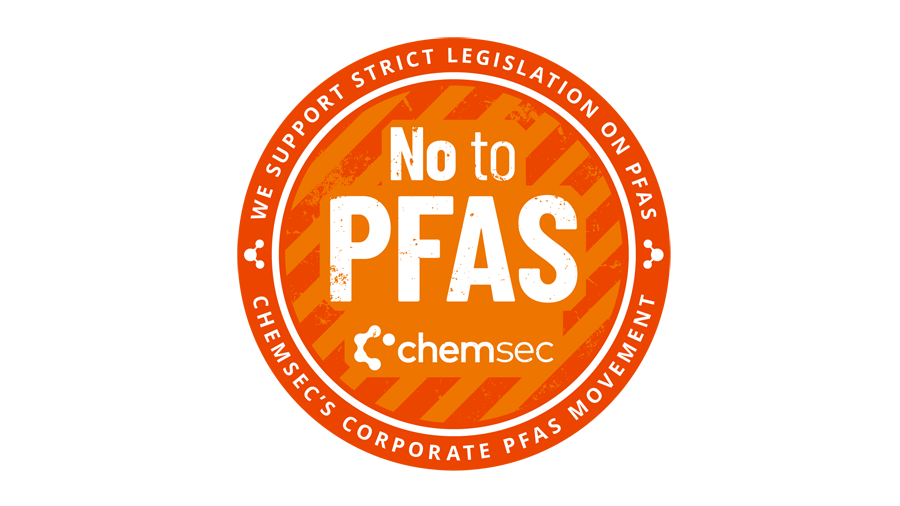PFAS, or “forever chemicals”, are a group of at least 10,000 man-made chemicals of similar structure and properties. They are persistant, resistant to water, grease, dirt and heat, and common components of non-stick frying pans, child car seats and fast-food containers, as well as firefighting foam and turnout gear.
PFAS chemicals can also be toxic and bioaccumulative, and are linked to a number of diseases, including liver damage, decreased fertility, asthma, thyroid disease and various forms of cancer. Since they have been widely used in production since the 1950’s, PFAS can be found in the bloodstream of 97% of the world’s population.
Despite their similar structure and properties, only a few PFAS chemicals have been banned or restricted from use, for example PFOA and PFOS. This often leads to “regrettable substitution”, where one restricted PFAS is simply switched to an often equally bad – or worse – unregulated “cousin”.
5 very concerning facts about PFAS:
1️⃣ In the United States, nearly two-thirds of the population receive municipally provided drinking water contaminated by PFAS with 97% of all Americans having measurable levels of PFAS in their blood.
2️⃣ Direct healthcare costs linked to PFAS exposure are estimated to be €52-84 billion every year.
3️⃣ At least 17,000 sites in Europe — as well as an additional 21,000 likely contaminated sites — are polluted with PFAS. More than two thousand of these PFAS hotspots contain levels so high they are deemed hazardous to human health.
4️⃣ PFAS have been found in the most remote places on the planet, far from regular human activity. Polar bears that hunt in the far north of the Arctic Sea have, for example, been found to have high concentrations of PFAS in their bloodstreams.
5️⃣ In 2022, the global market size for PFAS was €26 billion, which may sound like a lot. But it’s peanuts compared to the societal costs of PFAS, which amount to a staggering €16 trillion 👇👇👇
“Forever chemicals” everywhere
One problem all PFAS substances have in common is their persistence. The strong molecular fluor-carbon bonds make them almost completely resistant to degradation, which is what has given them the nickname “forever chemicals”.
The fact that they do not break down in nature, coupled with the fact that they spread out easily, has led to PFAS chemicals being detected all over the globe. Every region as well as every person and animal in the world now has measurable levels of PFAS. There have been many studies measuring PFAS levels in human blood, breast milk and urine. And in all of these studies, PFAS have been found — in all of the people tested. Even rainwater in the most remote areas of the planet contains PFAS above the proposed safety levels for drinking water. In fact, the pollution has gone so far that scientists have concluded that the planetary boundary for PFAS has been exceeded.
Once these “forever chemicals” are in the environment, there is, unfortunately, no way to take them back. And as long as they are still used and produced, these concerning levels will only increase.
Reports & webinars
If you want to dig deeper into the subject of PFAS, ChemSec offers several reports and webinars to increase your knowledge further. Check out the list below!
✒️ The top 12 PFAS producers in the world and the staggering societal costs of PFAS pollution
✒️ Check Your Tech: A guide to PFAS in electronics
✒️ How companies view PFAS and the EU’s restriction proposal
🖥️ Find out how to replace “difficult” PFAS uses with safer alternatives
🖥️ All you need to know about the PFAS restriction consultation
🖥️ The biggest chemicals legislation in years
Featured report

The top 12 PFAS producers in the world and the staggering societal costs of PFAS pollution
Health issues
Rising levels are a source of great concern since PFAS chemicals are linked to a number of health issues. There is a constant flow of publications linking PFAS exposure to health and environmental problems. This means that we are only beginning to understand the magnitude of the PFAS problem. Below, we’ll list some of the more common health issues linked to PFAS exposure.
Reproduction and development
PFAS affect reproductive organs and have effects such as reduced sperm count, increased time to pregnancy and increased risk for miscarriage. PFAS are also transferred from the mother to the child, posing risks for the unborn child such as low birth weight, accelerated puberty, bone variations and behavioural changes. PFAS also interfere with other parts of the hormone system, disrupting the thyroid function and altering cholesterol levels.
Cancer
PFAS are associated with a number of different types of cancer with one of the most well-studied PFAS officially classified as a possible carcinogen by the International Agency for Cancer Research (IARC). The two cancer types with the most evidence linked to PFAS are kidney cancer and testicular cancer.
There are also studies linking PFAS exposure to ovarian, breast, prostate and thyroid cancer as well as childhood leukaemia.
Impaired immune system
Among the most established health effects of PFAS is an impairment of the immune system. PFAS have also been linked to an increase in bronchitis and pneumonia in children, as a consequence of the lowered immune response. PFAS have also been linked to a lowered response to vaccines.
PFAS in wildlife
When it comes to studying PFAS in the environment, most studies focus on what this means for humans, but the same effects shown in humans can also be expected to occur in wildlife since a large part of human biology is shared with other species. High levels of PFAS have also been detected in a number of different animals — even in the most remote areas. In the polar regions, for example, high levels have been measured in polar bears, seals, foxes, orcas and otters.
Get all the latest PFAS updates!
Subscribe to our newsletter.
Regulation
It seems regulation is finally stepping up to address this vast and problematic family of chemicals. A comprehensive PFAS ban is expected in the European Union within the coming years and a range of regulatory actions are in the pipeline in other regions as well.
In the European Union
At the moment, EU regulation covers certain PFAS chemicals, for example, PFOS and PFOA and other substances that break down into these. In 2023, another restriction covering about 200 PFAS chemicals came into force. There are also restriction proposals for the PFAS chemicals PFHxA and PFHxS, as well as one intended for all PFAS use in firefighting foams.
The proposal for a so-called “universal” PFAS restriction in the EU was published in early 2023. The starting point for this is that all PFAS, including fluoropolymers and F-gases, should be restricted in all applications.
The proposal will now be discussed over a couple of years and is expected to come into force in 2025 or 2026. The main discussions forward will consider the proposed derogations from the restriction for certain applications where alternatives are not yet available. The derogations will be time-limited to 5 or 12 years. There are several consultation periods where stakeholders can provide input on the proposal. Information that is particularly valuable is information on the availability of alternatives for the applications that are proposed to be exempted from the restriction.
In the United States
In the absence of federal PFAS regulations in the US, several individual states have taken initiatives on their own to regulate them. Some of these regulations target specific product groups while others focus on especially vulnerable population groups such as children and workers.
California, Maine and New York already have some PFAS bans in place with even more set to come into force in the coming years. Before 2028, Washington, Minnesota, Vermont, Maryland, Colorado, Connecticut and Hawaii will also introduce PFAS regulations.
Are all PFAS the same?
The PFAS group is diverse in terms of structure, and there is a debate as to whether it is correct to regulate the whole group. Fluoropolymers and fluorinated gases, in particular, have caused a big debate around this.
The production of fluoropolymers is especially problematic since the surrounding areas become heavily polluted. The waste phase is also difficult to control and leads to pollution.
When it comes to fluorinated gases (so-called F-gases), the main problem is that they break down into TFA, which is a PFAS chemical found in increasingly high amounts in the aquatic environment. Moreover, these gases account for 63% of PFAS emissions.
ChemSec vs PFAS: the rap battle
What companies can do about PFAS
The PFAS Movement is an advocacy campaign coordinated by ChemSec where over a hundred consumer brands worth more than €130 billion strongly support a comprehensive ban on “these harmful “forever chemicals”. 108 companies dedicated to phasing out PFAS chemicals from products and processes have joined the movement since it first started in 2020. Your company can join too!

Identify PFAS in your supply chain
PFAS chemicals are used in many product categories, even where you least expect it. ChemSec’s online tool PFAS Guide alerts companies to products likely to contain PFAS and gives advice on how to phase them out.

Find alternatives to PFAS


